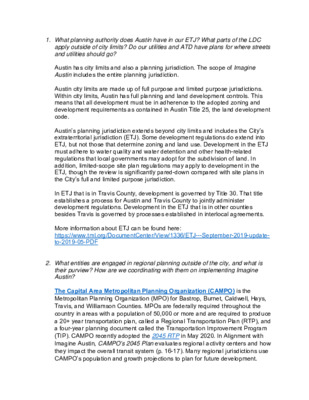Questions from 2-19-2020 SAPJC — original pdf
Backup

1. What planning authority does Austin have in our ETJ? What parts of the LDC apply outside of city limits? Do our utilities and ATD have plans for where streets and utilities should go? Austin has city limits and also a planning jurisdiction. The scope of Imagine Austin includes the entire planning jurisdiction. Austin city limits are made up of full purpose and limited purpose jurisdictions. Within city limits, Austin has full planning and land development controls. This means that all development must be in adherence to the adopted zoning and development requirements as contained in Austin Title 25, the land development code. Austin’s planning jurisdiction extends beyond city limits and includes the City’s extraterritorial jurisdiction (ETJ). Some development regulations do extend into ETJ, but not those that determine zoning and land use. Development in the ETJ must adhere to water quality and water detention and other health-related regulations that local governments may adopt for the subdivision of land. In addition, limited-scope site plan regulations may apply to development in the ETJ, though the review is significantly pared-down compared with site plans in the City’s full and limited purpose jurisdiction. In ETJ that is in Travis County, development is governed by Title 30. That title establishes a process for Austin and Travis County to jointly administer development regulations. Development in the ETJ that is in other counties besides Travis is governed by processes established in interlocal agreements. More information about ETJ can be found here: https://www.tml.org/DocumentCenter/View/1336/ETJ---September-2019-update- to-2019-05-PDF 2. What entities are engaged in regional planning outside of the city, and what is their purview? How are we coordinating with them on implementing Imagine Austin? The Capital Area Metropolitan Planning Organization (CAMPO) is the Metropolitan Planning Organization (MPO) for Bastrop, Burnet, Caldwell, Hays, Travis, and Williamson Counties. MPOs are federally required throughout the country in areas with a population of 50,000 or more and are required to produce a 20+ year transportation plan, called a Regional Transportation Plan (RTP), and a four-year planning document called the Transportation Improvement Program (TIP). CAMPO recently adopted the 2045 RTP in May 2020. In Alignment with Imagine Austin, CAMPO’s 2045 Plan evaluates regional activity centers and how they impact the overall transit system (p. 16-17). Many regional jurisdictions use CAMPO’s population and growth projections to plan for future development. The Capital Area Council of Governments (CAPCOG) was created June 26, 1970, pursuant to the Regional Planning Act of 1965, as amended, Chapter 391 of the Texas Local Government Code. The Council's purpose is to encourage and facilitate coordination on regional issues. CAMPO’s regional planning initiatives include air quality and natural resources planning, commuter programs and other regional planning efforts by providing researched analyses, coordinating policy discussions, and conducting community outreach. CAPCOG also coordinates a number of GIS services throughout the 10-county region. Travis County Counties in Texas have limited tools to regulate development. While cities need to determine whether a proposed ordinance violates state law, counties need to determine whether a proposed ordinance is allowed by state law. Travis County collaborates on the implementation of Imagine Austin through its Travis County Land, Water, Transportation Plan. Adopted in 2014, the purpose of this plan is to: Identify where the county will incent development Identify where the county will incent conservation Provide guidance to minimize incompatible land uses Guide consistent collaboration with other governments and agencies at the regional and local level Help coordinate private and public investment Travis County’s growth strategy (p. 23) builds on the CAMPO’s 2040’s Draft Activity Centers and Imagine Austin. 3. How do the organizations in our MSA compare to Dallas or Houston/Galveston, and what resources (i.e. federal grants) do those other regions use? Do we utilize those same resources? Regional planning agencies administer federal and state grants regarding solid waste, Homeland Security, disaster recovery/flood mitigation, EPA TAG (superfund), transportation, and CDBG. HGAC Livable Center Studies is an example of some of the planning work done by other regional planning organizations. A listing of HGAC’s programs and projects can be found in their budget and service plan: http://www.h-gac.com/financial- information/documents/2020-budget-and-service-plan.pdf NCTCOG’s programs and projects can be found in their budget: https://www.nctcog.org/getattachment/Agency-Administration/Fiscal- Management/2020/Annual-Fiscal-Program-FY2020.pdf.aspx?lang=en- US&ext=.pdf